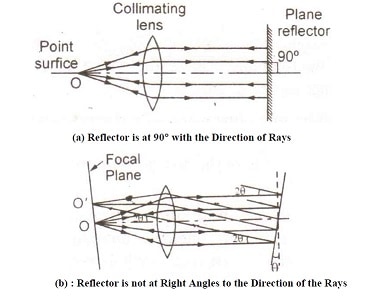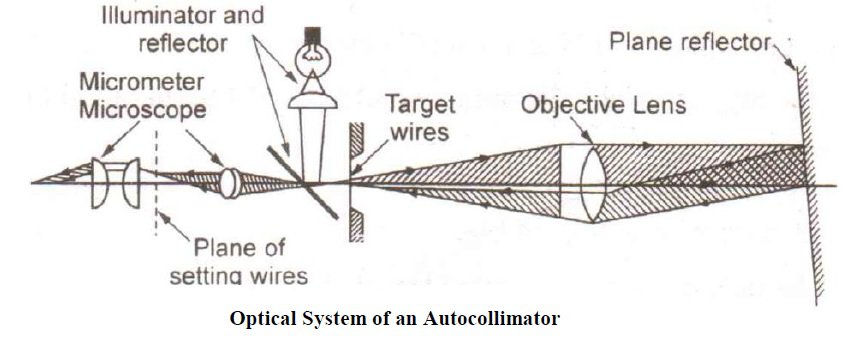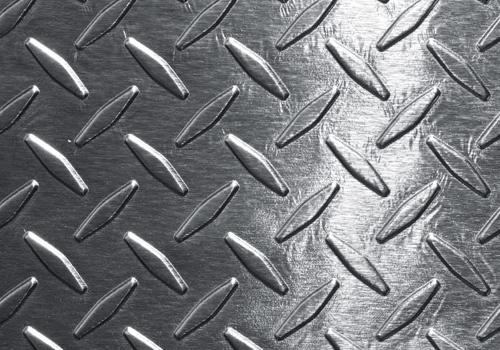Autocollimators are optical instruments that measure angular displacements with high sensitivity. They are used to align optical components and measure optical and mechanical deflections.
Self-collimation principle:
The two main principles used in an autocollimator are
(a) the projection and refraction of a parallel beam of light by a lens, and
(b) the change in direction of an angle reflected from a flat reflecting surface with change in angle of incidence.
 Autocollimator – Working Principle and Application
Autocollimator – Working Principle and ApplicationTo understand this, let's imagine a converging lens with a point source of light O at its main focus, as shown in Figure a. When a beam of light strikes a flat reflective surface, part of the beam is absorbed and the other part is reflected back. If the angle of incidence is zero, that is, the incident rays fall perpendicular to the reflecting surface, the reflected rays retrace the original path. When the reflecting plane is tilted at a certain angle, the total angle through which the light is deflected is twice the angle through which the mirror is tilted. Thus, alternatively, if the incident rays are not at right angles to the reflecting surface, they can be brought into the focal plane of the light sources by tilting the reflecting plane at an angle that is half the angle of reflection, as shown in Figure b .
Now, in the diagram, OO' = 2Θ × f = x, where f is the focal length of the lens.
Thus, by measuring the linear distance x, the slope of the reflecting surface Θ can be determined. The position of the final image does not depend on the distance from the reflector to the lens. If, however, the reflector is moved for a long time, the reflected ray will completely escape the lens and no image will be formed.
Autocollimator operation:
In practice, the work surface whose inclination is to be obtained forms the reflecting surface and the displacement x is measured by a precision microscope calibrated directly to the inclinationΘ values.
The optical system of an autocollimator is shown in Figure The target wires are illuminated by the electric lamp and act as a light source, as it is not convenient to view the reflected image from a point and then accurately measure the x displacement. The image of the illuminated wire after being reflected from the surface being measured is formed in the same plane as the wire itself. The ocular system that contains the micrometer microscope mechanism has a pair of adjustment lines that can be used to measure image displacement, adjusting to the original cross lines and then moving to those of the image.
 autocollimator construction diagram
autocollimator construction diagram Typically, calibration is provided with the instrument. Thus, the angle of inclination of the reflecting surface by division of the micrometer scale can be read directly.
Autocollimators are quite accurate and can read down to 0.1 seconds, and can be used at distances of up to 30 meters.
Types of autocollimators
1) Visual Autocollimators –
Visual autocollimators measure the angle of optically flat reflective surfaces (1/4 wave or better) in arc seconds by viewing a graduated reticle through an eyepiece. The greater the focal length of the visual autocollimator, the greater the angular resolution and the smaller the field of view.
2) Digital Autocollimators –
- Autocollimators are PC-based instruments designed to operate in a laboratory as well as a machine shop environment.
- Use an electronic photodetector to detect the reflected beam.
- No external controller is required.
- Advantages: 1) High precision. 2) Real-time measurements. 3) User-friendly interface. 4) Creation of data reports and transfer into other programs.
Factors governing the specification of an autocollimator
(i) Focal length
The focal length determines the basic sensitivity and angular measurement range of the instrument. A longer focal length provides greater sensitivity and measurement accuracy (due to the greater linear displacement for a given reflector tilt). But as the focal length increases, the measuring range decreases accordingly. Furthermore, a longer focal length affects the mechanical extension of the tube.
(ii) Size of objective aperture
When large apertures are used, light conditions are more favorable and evaluation of results is easier and more accurate. A long distance between the mirror and the autocollimator requires a relatively large aperture and a larger reflector for satisfactory image contrast.
(iii) Type of beam splitter
A geometric beam splitter results in smaller image angles but greater image brightness. They are mainly used with small targets and due to their internal layout cannot be used for measuring corner cubes. A physical beam splitter is recommended in most cases due to the larger measuring range.
(iv) Fixed or variable distance configuration
When the distance between the autocollimator and target mirror remains fixed, extremely close readings can be taken and repeatability is excellent. For variable focal length, an objective tube with focus adjustment is used.
Application of autocollimator:
Autocollimators are used by the optical industry and mechanical engineers in a variety of applications. Its specific functions include precision alignment, angular motion detection, angular pattern checking and angular monitoring over long periods.
Test Application
Autocollimators can be used in testing
- parallelism with collimator and telescope
- opaque wedges and parallel flat plates
- transparent wedges
- angles in glass prisms
- the accuracy of rotary tables and index tables
- camera goals
These optical instruments are also used in testing the flatness of reflective surfaces, controlling wedges and parallel flat plates, and parallel measuring cylindrical holes.
Measurement applications
In addition to testing applications, autocollimators can be used to measure the
- radius of concave and convex spherical surfaces
- rear focus of lenses and optical systems
- centering error of spherical surfaces
- lens centering error in transmission
- parallelism or perpendicularity of two surfaces
Additional applications include the
- radius measurement of concave and convex spherical surfaces
- relative measurement of the angular error of prisms
- slide pitch and yaw measurement
- parallel roller configuration
Finally, autocollimators can be used to measure straightness, flatness, angle of rotation, and squareness between a vertical angle and the base of the machine.
Advantages of Autocollimators:
- Measure straightness and levelness
- Used for higher precision measurement.
- To check quadrature and parallelism.
- Easy to set up and operate.
- Used to align components.
- Measuring small angles.
Disadvantages of Autocollimators:
- Regular maintenance is required.
- Difficulty in positioning and identification.
- Late.
- Requires sample cutting and processing for tracking by the detector.










